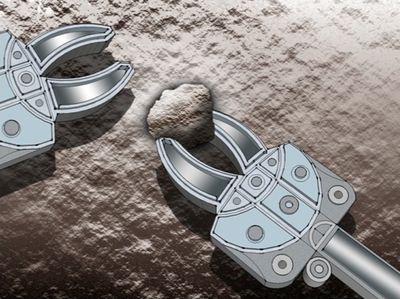NASA’s new robot challengeby Ben Brockert
|
| In essence, a fully autonomous robot is to venture around a course collecting pre-defined samples and bringing them back to a platform. |
The rules are presented as a series of individual web pages for each section and subsection. A file containing the full rule set is not available “to limit access to a document that could be re-posted, shared, or kept and misinterpreted as a final set of rules”. A good summary of the challenge is not included in the rules, and it appears that the only way to come to an understanding of the objective is to read the entire rule set. An attempt to summarize follows:
In essence, a fully autonomous robot is to venture around a course collecting pre-defined samples and bringing them back to a platform. The robot fits within a 1.5-meter cube, weighs less than 80 kilograms, and does not travel faster than 2 meters/second. The robot can’t use sensors or systems that require atmosphere or terrestrial navigation equipment, like an air-breathing engine or GPS, respectively.
The ten samples to be retrieved are from 1–20 centimeters in size and weigh between 2 grams and 1 kilogram. They include such items as a tennis ball, hockey puck, PVC tube, wooden cube, “rock, painted yellow”, and three “non-ferrous metal object[s] engraved with a unique, rectilinear, identifying mark”, which sounds like a penny or similar token. The samples are distributed around the site at least 25 meters away from each other.
The competition field is an 80,000 square meter outdoor field, with “open rolling terrain and immovable obstacles (trees, large rocks, water hazards, etc).” Teams get a satellite image of the area and “limited topographical data” before the competition. Within that field the starting platform is a square plywood surface, two meters to a side and 15 centimeters above the field, with a ramp sloping to the field. The platform is moved and reoriented for each level 2 attempt. The robot is disqualified if it ever touches the boundary of the area, defined by orange snow fence.
Being fully autonomous, the robot must be easily shut off by the competition judges, as well as a wireless “pause” button used for de-conflicting robots when operating on the course simultaneously.
The competition happens with two levels. Any team passing the first level is guaranteed a small prize and a chance at level two. Level one is to return a single “pre-cached” sample to the starting platform in fifteen minutes. Level two involves returning as many samples as possible to the starting platform within two hours; for no explained reason the samples may not touch each other on the platform or in the robot or those samples are disqualified. Presumably to prevent a robot from simply bulldozing as much of the site as possible onto the platform, the rules require that “samples must comprise at least 50% of the mass of any items returned to the starting platform”.
| Time will tell whether the eventual rule set will drive innovation and a variety of approaches, like the regolith excavation challenge, or set up a problem so difficult no one will win, as in the regolith oxygen and strong tether challenges. |
The prize money is then split up amongst the teams. Each team completing level 1 gets an even share of $50,000, up to $5,000. The remainder of the prize is split up amongst the three top scorers in level 2 via an ill-defined prize distribution algorithm. A total of 25 points are available in the competition, with $1.5 million awarded for attaining 15 or more points. The prize purse as defined by NASA is $1.5 million, but there is no explanation where the additional funds would come from if the $1.5 million first place prize in level two and the full $50k level one prizes are distributed.
One particularly worrisome requirement in the “Deadlines & Documentation” section says, “Upon arrival at the event: Each team must provide a full printout of their robot code along with a schematic of all electrical components for each robot.” Such a rule would inevitably have a chilling effect on teams entering into the competition; the intellectual property generated in prior autonomous robot competitions like the DARPA Grand Challenges has become the core of commercial businesses.
The rules do not specify much about the environmental conditions of the competition itself. The competition could occur in rain showers, snow, heavy fog, or sleeting, but not during lightning. It could be at high noon or midnight during a new moon. Considering that optical means will be the only way of finding some samples, the lack of specification on ambient light increases the difficulty of the challenge. Different teams competing with different ambient lighting will add an undesirable variable to the results.
The competition is operating on a fast timeline. The competition occurs 12 months after final rules are posted, and the draft rules are only open for comment until June 17, a week and a half from today. Time will tell whether the eventual rule set will drive innovation and a variety of approaches, like the regolith excavation challenge, or set up a problem so difficult no one will win, as in the regolith oxygen and strong tether challenges.
More information about the challenge is available from WPI, Challenge.gov, and NASA’s Centennial Challenges program.
